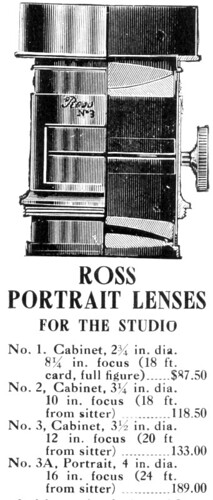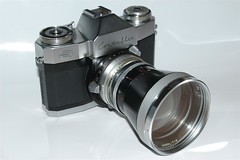Difference between revisions of "Portrait lens"
(replaced unavailable photo with new one; CP -> CW membership; rights) |
m (+wikilink) |
||
| (8 intermediate revisions by 4 users not shown) | |||
| Line 1: | Line 1: | ||
| + | {{glossary}} | ||
{{Flickr image | {{Flickr image | ||
| image_source=http://www.flickr.com/photos/89864432@N00/4271830051/in/pool-camerawiki | | image_source=http://www.flickr.com/photos/89864432@N00/4271830051/in/pool-camerawiki | ||
| Line 6: | Line 7: | ||
}} | }} | ||
| − | + | A lens of somewhat longer than standard focal length is often termed a '''portrait lens'''. This is due to the suitability of such lenses for making portraits showing just a subject's face, and perhaps a bit of their shoulders. | |
| − | 35mm cameras with portrait lenses | + | If a face is photographed from too close a position (say, under 2.5 feet or 75 cm) the subject's nose can appear unattractively exaggerated. On the other hand, an image made with a long telephoto from extreme distances will show the sides of the head to an unnatural degree, making it appear ballooned out. Thus, a "portrait" focal length is one allowing the photographer to frame a head-and-shoulders shot from some middle distance—perhaps 5 feet or 1.5 meters. |
| + | |||
| + | To achieve this tighter framing, portrait lenses typically have an angular coverage of 25° or 30° (on the diagonal), where a standard lens covers 50° to 60°. This implies focal lengths of about 1.5 to 2.5 times the image diagonal of the film or [[sensor]] format. In other words, 45mm would be considered a "portrait" focal length on the sensor size of a [[Micro Four Thirds]] camera; while a 300mm lens would give the equivalent angle of view on a 4x5 [[view camera]]. | ||
| + | |||
| + | Another consideration for portraiture is that the photographer will likely wish to blur the background to de-emphasize distracting detail. A portrait lens typically offers a relatively large [[entrance pupil]] (the physical diameter of the aperture) which greatly facilitates this. For this reason, portrait lenses offering [[Lens#Lens_Speed|speeds]] of f/2.0 or wider may become some of the most sought-after items in a particular manufacturer's lens lineup. | ||
| + | |||
| + | Beyond simply offering selective focus to a photographer, portrait lenses may be explicitly designed to provide pleasing [[bokeh]]—the perception of softness and smoothness in the out-of-focus area. In some designs this may involve deliberate undercorrection of [[spherical aberration]] or other aberrations ( "clinical" sharpness which reveals every wrinkle and blemish may not be a desired goal for portraiture). Some manufacturers go further, and offer dedicated soft-focus portrait lenses: these may provide adjustable amounts of spherical aberration, or aperture stops with multiple perforations, with the result that highlights show a slight halo around them. | ||
| + | |||
| + | The first portrait lens was the fast [[Petzval lens]], invented in 1841 by [[Jozef Maximilián Petzval]]. The lens had a typical focal length for portraiture, with 149mm for 80mm plate diagonal comparable to a 80mm lens for [[35mm film]]. Previous lenses of the era demanded exposure times measured in minutes, whilst the Petzval lens could reduce exposure time to a more tolerable 30 seconds since it was the first really fast photographic lens with a maximum aperture of circa f3.5. The residual aberrations of the Petzval design gave it a softness which a few portrait photographers continue to find useful today. The lens delivered a superb sharpness for the image center, and despite of vignetting and abberations visible on the image sides and edges it was a dominating portrait lens design throughout the rest of the 19th century. | ||
| + | |||
| + | |||
| + | ==35mm cameras with portrait lenses== | ||
{|class=plainlinks | {|class=plainlinks | ||
||[http://www.flickr.com/photos/siimvahur/2940555517/in/pool-camerawiki http://farm4.static.flickr.com/3198/2940555517_c937efa308_m.jpg] | ||[http://www.flickr.com/photos/siimvahur/2940555517/in/pool-camerawiki http://farm4.static.flickr.com/3198/2940555517_c937efa308_m.jpg] | ||
| Line 18: | Line 30: | ||
||[[Tessar|Pro-Tessar]] 115mm f4.0 | ||[[Tessar|Pro-Tessar]] 115mm f4.0 | ||
|- | |- | ||
| − | ||image by Siim Vahur {{with permission}} | + | ||<small>image by {{image author|Siim Vahur}}</small> {{with permission}} |
| − | ||image by Voxphoto {{non-commercial}} | + | ||<small>image by {{image author|Voxphoto}}</small> {{non-commercial}} |
| − | ||image by John F Richardson {{with permission}} | + | ||<small>image by {{image author|John F Richardson}}</small> {{with permission}} |
|} | |} | ||
| − | [[Category: | + | [[Category:Lenses]] |
Latest revision as of 22:57, 17 May 2012

|
| the Ross Portrait Lens, a design similar to the Petzval lens |
A lens of somewhat longer than standard focal length is often termed a portrait lens. This is due to the suitability of such lenses for making portraits showing just a subject's face, and perhaps a bit of their shoulders.
If a face is photographed from too close a position (say, under 2.5 feet or 75 cm) the subject's nose can appear unattractively exaggerated. On the other hand, an image made with a long telephoto from extreme distances will show the sides of the head to an unnatural degree, making it appear ballooned out. Thus, a "portrait" focal length is one allowing the photographer to frame a head-and-shoulders shot from some middle distance—perhaps 5 feet or 1.5 meters.
To achieve this tighter framing, portrait lenses typically have an angular coverage of 25° or 30° (on the diagonal), where a standard lens covers 50° to 60°. This implies focal lengths of about 1.5 to 2.5 times the image diagonal of the film or sensor format. In other words, 45mm would be considered a "portrait" focal length on the sensor size of a Micro Four Thirds camera; while a 300mm lens would give the equivalent angle of view on a 4x5 view camera.
Another consideration for portraiture is that the photographer will likely wish to blur the background to de-emphasize distracting detail. A portrait lens typically offers a relatively large entrance pupil (the physical diameter of the aperture) which greatly facilitates this. For this reason, portrait lenses offering speeds of f/2.0 or wider may become some of the most sought-after items in a particular manufacturer's lens lineup.
Beyond simply offering selective focus to a photographer, portrait lenses may be explicitly designed to provide pleasing bokeh—the perception of softness and smoothness in the out-of-focus area. In some designs this may involve deliberate undercorrection of spherical aberration or other aberrations ( "clinical" sharpness which reveals every wrinkle and blemish may not be a desired goal for portraiture). Some manufacturers go further, and offer dedicated soft-focus portrait lenses: these may provide adjustable amounts of spherical aberration, or aperture stops with multiple perforations, with the result that highlights show a slight halo around them.
The first portrait lens was the fast Petzval lens, invented in 1841 by Jozef Maximilián Petzval. The lens had a typical focal length for portraiture, with 149mm for 80mm plate diagonal comparable to a 80mm lens for 35mm film. Previous lenses of the era demanded exposure times measured in minutes, whilst the Petzval lens could reduce exposure time to a more tolerable 30 seconds since it was the first really fast photographic lens with a maximum aperture of circa f3.5. The residual aberrations of the Petzval design gave it a softness which a few portrait photographers continue to find useful today. The lens delivered a superb sharpness for the image center, and despite of vignetting and abberations visible on the image sides and edges it was a dominating portrait lens design throughout the rest of the 19th century.
35mm cameras with portrait lenses

|

|

|
| Helios-40 85mm f1.5 | Canon FDn 100mm f2.0 | Pro-Tessar 115mm f4.0 |
| image by Siim Vahur (Image rights) | image by Voxphoto (Image rights) | image by John F Richardson (Image rights) |